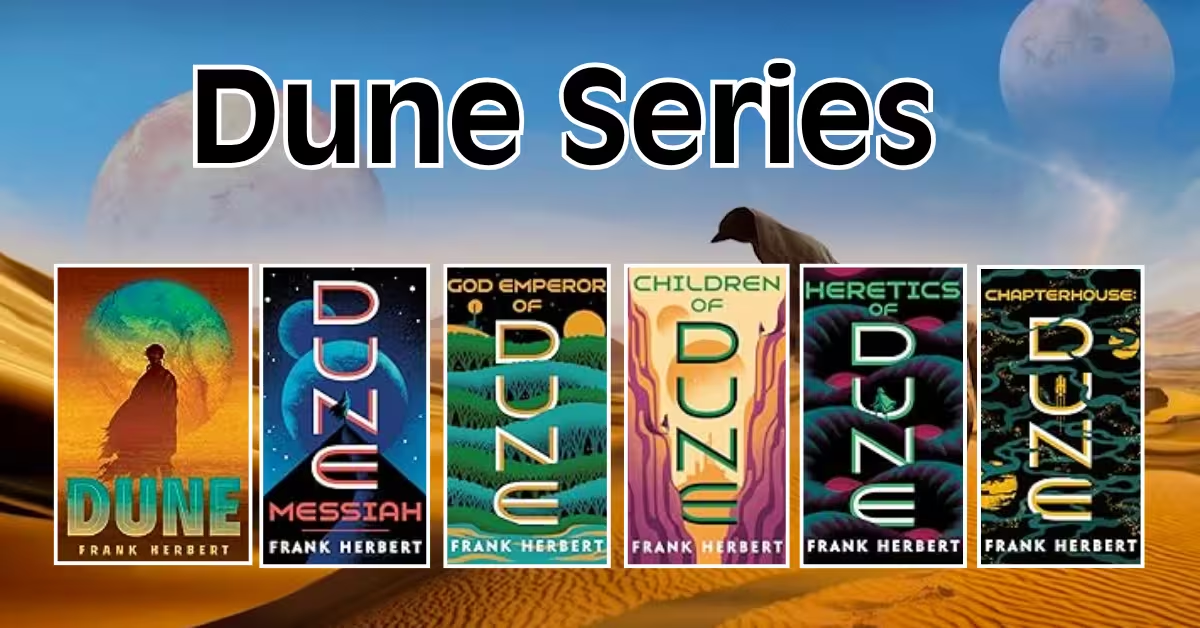A desert world where water is life, prophecy is policy, and leadership can spark unintended crusades—Dune isn’t just a novel; it’s a system of ideas that still feels startlingly modern.
Key facts
| Author | Year | Series (Herbert originals) | Avg. read time |
|---|---|---|---|
| Frank Herbert | 1965 | 6 novels | ~12–14 hours at ~250–300 wpm |
1965 date from the imprint; the “Dune Chronicles” list shows Herbert’s six core novels.
Table of Contents
1. Dune Plot Summary
Below are spoiler-filled plot summaries of Frank Herbert’s six original Dune novels. Each runs ~500–600 words and includes light, inline citations to passages and introductions from your uploaded editions to anchor key details.
1.1 Dune (1965)
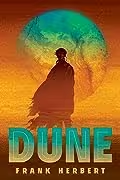
On the ocean world of Caladan, young Paul Atreides trains under the watchful eyes of his father, Duke Leto, and lieutenants Gurney Halleck and Duncan Idaho, while his Bene Gesserit mother, Lady Jessica, hones his mind and body for the deadly realpolitik of the Imperium. Paul’s early scenes emphasize combat training and the looming move to Arrakis—an arid planet and sole source of the precious spice melange that underpins space travel, finance, and longevity.
The Padishah Emperor transfers Arrakis from House Harkonnen to House Atreides, baiting a trap. Duke Leto knows the hand behind the ambush is the Emperor, who will disguise his Sardaukar legions in Harkonnen livery to crush the rising popularity of House Atreides.
Once on Arrakis, political and ecological realities tighten: the Spacing Guild’s dependence on spice, Fremen desert culture and survival tech, and the lethal sandworms shape every decision.
Within the Keep at Arrakeen, treachery blooms. Dr. Wellington Yueh, a Suk–conditioned physician, breaks his Imperial Conditioning under the Harkonnens’ leverage, sabotaging House defenses and enabling a night assault that kills Duke Leto.
(Even the book’s in-world “Dictionary of Muad’Dib” marks Yueh as the betrayer.) Fleeing into the deep desert, Paul and Jessica find refuge with the Fremen, a fiercely disciplined people who harvest spice and dream of transforming Arrakis. Paul survives trials, learns the desert’s ways, and adopts the name “Muad’Dib.” There he also begins to realize the terrifying breadth of his prescience—the Jihad his name could ignite across the galaxy.
Alliances crystalize around military and ecological leverage. In strategy sessions that double as political seminars, Paul sees how the Landsraad’s fear of Sardaukar oppression can be turned into a coalition; he contemplates an ultimatum that could make Arrakis the rallying cry against Imperial tyranny.
As spice raids, guerrilla strikes, and sandworm-riding tactics bleed Harkonnen and Imperial forces, Paul’s power consolidates. The Fremen’s water discipline and technology serve both survival and insurgency, while Paul’s visions reveal how the Guild’s addiction to safe courses leads to stagnation—making them vulnerable to his ascendancy.
In the climactic confrontation, Paul brings the Emperor, the Bene Gesserit, and House Harkonnen to heel in Arrakeen. He defeats Feyd-Rautha, forces Shaddam IV to abdicate, and marries Princess Irulan, trading romance for legitimacy while remaining emotionally bound to his Fremen consort, Chani. The victory crowns him Emperor and sets the stage for consequences he already foresees but cannot fully avert.
Though widely read as a hero’s-journey epic, Dune deliberately seeds future caution: the ecology of scarcity, the combustible fusion of religion and politics, and the danger of following a charismatic savior. Brian Herbert’s introduction underscores those layered themes and the mythic scaffolding around Paul’s ascent.
1.2 Dune Messiah (1969)
Twelve years after the fall of House Corrino, Paul Muad’Dib rules as Emperor—but at a price. In his name, a fanatical Jihad has burned across the galaxy.
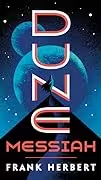
The man who saw himself becoming a cautionary tale now lives inside it, navigating the narrow corridors of prescient inevitability while his enemies—some open, some intimate—close in. Brian Herbert’s framing materials highlight how this sequel “inverts” the victorious myth of the first novel, exposing the dark undertow of messianic politics.
A delicate, lethal conspiracy forms among the Bene Gesserit, the Spacing Guild, and the Tleilaxu—each with reasons to check Muad’Dib’s dominance.
Their instrument is a ghola named Hayt, grown from the flesh of Paul’s fallen swordmaster, Duncan Idaho. Hayt arrives at court as a Tleilaxu “gift,” laden with hidden triggers meant to destabilize Paul’s equilibrium and, perhaps, murder his soul. The plot interweaves with the so-called “Dune Tarot,” a mass-market prescient tool that fuzzes Paul’s sight lines, complicating his control of the future.
Within the Imperial household, political marriage and private love collide. Paul’s official wife, Princess Irulan, has been kept from bearing his heir—partly by politics, partly by Paul’s loyalty to Chani. Irulan’s position in the conspirators’ web (and her control over contraceptives) becomes a bitter hinge on which dynastic succession could swing.
The text foregrounds that sham marriage and its consequences for the next generation.
Attacks come spiritual, psychological, and physical. A Face Dancer assassin nearly succeeds; emboldened priests and bureaucrats misread Paul’s restraint; disinformation corrodes public trust. Meanwhile, Chani’s longed-for pregnancy finally succeeds when she abandons contraceptives, but her health falters—another edge to the conspirators’ blade.
Paul’s prescience becomes both shield and trap. In a pivotal crisis he is physically blinded by a stone burner, yet walks “by vision” through the desert, obeying Fremen law and leadership ritual even as he edges toward a sacrifice he has foreseen.
The ghola-Hayt, torn between implanted Tleilaxu compulsions and Duncan’s resurrecting memories, becomes the story’s moral fulcrum—proof that identity and love can defy programming.
The conspiracy “succeeds” only in the sense that it forces the tragic outcome Paul has tried to avoid. Chani dies bearing twins—Leto II and Ghanima—securing the Atreides line while destroying Paul’s personal world. In the aftermath, Paul abdicates power in the most Fremen way possible: he walks into the desert, a blind man choosing the ancient law, a living indictment of the messiah-fantasy others built around him. Alia, his sister, becomes regent for the twins; Irulan, chastened, will become their teacher; and Duncan lives again, now truly himself.
The narrative thus pivots the saga from triumphant revolution to the costs of empire and the ethics of power—a transition the book telegraphs from its opening interrogations of “surface truth.”
1.3 Children of Dune (1976)
Years after Paul’s disappearance, Arrakis has been partially terraformed; water and greenery spread, undermining the old desert lifeways.
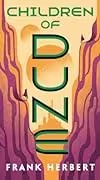
Alia rules as regent for Paul’s children, the preternaturally aware twins Leto II and Ghanima. But Alia bears a fatal wound: in the spice trance that made her a Reverend Mother in the womb, she took in ancestral memories, including the consciousness of the dead Baron Harkonnen.
That “Abomination” begins to possess her, and the regency curdles toward tyranny—something Lady Jessica realizes as she returns to Arrakis and “once more into the dragon’s mouth.”
Political factions multiply. House Corrino loyalists plot to restore imperial fortunes via Prince Farad’n. Fremen traditionalists resent ecological “success” that threatens stillsuit culture and sandworm cycles.
Within the Keep, courtiers like Javid (Alia’s creature) and the priesthood exploit public religiosity surrounding the legend of Muad’Dib. Jessica’s Bene Gesserit instincts tell her that the problem isn’t only external enemies but Alia’s spiritual collapse—something she weighs even as she calculates how to protect her grandchildren and the Atreides line.
Meanwhile, rumors spread of a mysterious Preacher denouncing the church of Muad’Dib—a voice that might be Paul himself, stripped of titles and warning against deifying men. Against this backdrop, Leto II and Ghanima play a long game.
Precocious, burdened with ancestral memories like their aunt Alia but more balanced, they navigate assassins and political traps. Leto conceives a path beyond dynastic survival—a way to break humanity out of cyclical tyranny and stagnation.
The twins execute a dangerous deception: Ghanima allows others to believe she’s been conditioned toward Farad’n while Leto stages his own apparent death and undertakes a solitary desert ordeal. His goal is radical: merge with sandtrout, the larval form of worms, binding his body to Arrakis’s ecology and opening a prescient horizon beyond any Atreides before him.
That metamorphosis will make him inhuman in aspect and almost godlike in reach, but it’s the only way to guide humanity onto the “Golden Path” he begins to glimpse.
In the end, Alia’s possession is laid bare. Cornered by the twins’ maneuvers and her own conscience, she chooses death rather than exist as the Baron’s puppet.
The Corrino gambit is co-opted rather than crushed: Farad’n is educated in Fremen discipline and Bene Gesserit methods, then folded into an Atreides future rather than allowed to threaten it. Stylistically and thematically, the novel completes the first Atreides arc: Paul’s myth is demystified; the twins assume agency; and Leto II’s choice marks the hinge from human empire to something stranger.
Children of Dune thus ends as a prologue to millennia—a seed of the Golden Path that will bloom in terrible form. (The return of Jessica and the huge public scenes on the Arrakeen landing plain foreground the sense of history pressing on the present.)
1.4 God Emperor of Dune (1981)
Three and a half millennia later, Leto II rules as an immortal “god emperor,” a human–sandworm hybrid whose body is encased in living sandtrout carapace.
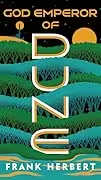
He has enforced a long, often brutal peace to shepherd humanity along the Golden Path—his grand design to ensure the species’ survival against prescient tyranny and existential threats.
The novel’s introduction stresses how different this book is from the earlier adventure mode: an extended meditation on power, religion, and control under an undying holy tyrant.
Leto’s empire is ritualized and stagnant by design. He rations spice to the Guild and the Bene Gesserit, breaking their monopolies, and hoards the greatest reserve himself. He cultivates resentment, keeps technology in check, and manipulates bloodlines, all to produce one critical lineage: a human population capable of scattering and resisting prescient capture.
His journals, preserved at Dar-es-Balat, explain his origins and purpose as the son of Paul and Chani and as heir to Fremen ecological dreams—now inverted in practice, since true sandworms no longer roam free and Arrakis is mostly green, save for Leto’s protected Sareer desert.
Against him move recurring human pieces. The Tleilaxu repeatedly supply Duncan Idaho gholas—some of whom are groomed to assassinate Leto—while the Bene Gesserit and Ixians probe for weaknesses.
Siona, a rebel descendant of the Atreides, becomes the keystone of Leto’s experiment: he needs her line to express a genetic trait that “hides” people from prescience, breaking the predictive prison that enables tyrants like him.
The dramatic tension gathers around whether Leto can orchestrate his own downfall at the right moment to trigger the outcome he wants. (A crypt scene with a lasgun-bearing Duncan underscores the perpetual dance of assassination and control.)
The finale consummates Leto’s design. Betrayed by those closest to him (as engineered), Leto is cast from his cart into water—the one element inimical to his hybrid form—where sandtrout peel away and his vast body disintegrates.
His death releases precursor elements that will eventually regenerate sandworms and spice cycles, even as it detonates the social order he maintained. In death, he wins: with centralized control gone and with Siona’s prescience-insulating trait seeded into humanity, the species explodes into the Scattering—beyond the grasp of any future oracle or empire.
The book’s paratext and introductions frame Leto as the most unusual figure in science fiction: a terrifying savior whose tyranny was a sacrifice to prevent worse futures.
1.5 Heretics of Dune (1984)
Centuries after Leto II’s fall, the galaxy he engineered has changed beyond recognition. Humanity has returned from the Scattering—vast diaspora populations hardened by struggle and technological cunning.
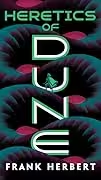
Among the returnees are the Honored Matres, a ruthless sisterhood who wield weaponized sexuality and overwhelming force. They are, pointedly, not Bene Gesserit, though echoes of shared ancestry and training exist; their arrival threatens to erase the order the Sisterhood has tended since the Tyrant’s time.
Brian Herbert’s introduction foregrounds the ascendancy of women’s political power in this era and the perilous contest now unfolding.
The Bene Gesserit, led by Mother Superior Taraza, maneuver on multiple boards: fostering a Duncan Idaho ghola (again), cultivating the prodigy Bashar Miles Teg, and watching the desert planet Rakis (the former Arrakis), where sandworms have returned and a girl named Sheeana can command them.
Meanwhile, Tleilaxu Masters like Waff probe the Honored Matres’ origins and capabilities—even using Face Dancers to infiltrate them—while negotiating for advantage. Scenes between Waff and an Honored Matre reveal the latter’s methods and obsessions, including domination through sexual imprinting and a desperate interest in spice and axlotl tank secrets.
Strategically, both the Matres and the Sisterhood covet melange. Taraza reasons that those returning from the Scattering may be running out of “true spice,” making Rakis and the Tleilaxu essential—and therefore targets.
Her analysis ties money, biology, and war into a single projection: whoever controls reliable spice controls the post-Scattering order. The Sisterhood’s internal debates (and dissidence around the ghola project) show a House stretched thin as it tries to play long-game genetics against an enemy who doesn’t play by those rules.
Conflict erupts across multiple worlds: Gammu, Rakis, and Chapterhouse. The ghola Duncan begins to awaken layers of prior memory; Teg demonstrates tactical genius bordering on the superhuman; and Sheeana’s connection to the worms signals that religion and ecology still intertwine as power multipliers.
The Honored Matres, for their part, are not a mere mirror of the Bene Gesserit—they are an evolutionary offshoot forged by terrors in the deep Scattering, practiced in annihilation, and opaque even to Tleilaxu intelligence. (The Face Dancers’ reports and Waff’s fearful deductions underline this.)
Heretics closes on upheaval: catastrophes and coups reset the board; Sisterhood plans require new audacity; and the stakes escalate from planetary control to civilizational survival.
The novel reads as the opening movement of a concluding trilogy Herbert intended—one that pivots from the Tyrant’s controlled stagnation to wild, returned forces that the old Imperium structures can’t contain.
1.6 Chapterhouse: Dune (1985)
The Bene Gesserit have retreated to Chapterhouse, turning it into a crucible for survival while the Honored Matres ravage the Old Empire.
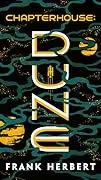
With Mother Superior Darwi Odrade at the helm, the Sisterhood fights a war of nerves and stratagems: seed cells across space, hide key assets in no-ships, and prepare the planet itself for desert transformation to host transplanted sandworms—rebuilding the ecological foundation of spice independence.
Early chapters capture Odrade’s relentless time pressure and the necessity of scattering Bene Gesserit cells before the “axe” falls.
Internal debates abound. Bellonda, Tamalane, and Odrade argue over risks: Duncan Idaho’s unpredictable ghola instincts, the no-ship’s secrets, Sheeana’s ambitions, and the training of Murbella—a captured Honored Matre who might become a hybrid weapon or a fatal breach. The text is saturated with Odrade’s strategic monologues: choose who scatters and who remains; accept total destruction over capture; and turn the Matres’ appetites into a trap.
Tactical moves accelerate. Chapterhouse begins its sand-desert transformation; Sheeana tends nascent worms; Duncan trains Teg’s child and analyzes the Sisterhood with an independence that unsettles everyone. Murbella, caught between indoctrinations, recognizes the hollowness in her former Sisterhood’s addiction to conquest and the different, colder power of Bene Gesserit discipline. Her arc from predator to potential leader becomes central to Odrade’s evolving plan.
The endgame is audacious: Odrade leads a high-risk diplomatic assault on the Honored Matres’ leadership (the “Spider Queen”) while setting snares that rely on the enemy’s predictability—turn their momentum into overreach.
Her private writings admit the possibility of catastrophe but insist that victory, if it comes, will be collective and adaptive rather than a single decapitating blow. The Sisterhood’s goal is not extermination but transformation of the conflict itself—reshaping power rather than destroying it.
Chapterhouse closes on unresolved flight and metamorphosis. A no-ship bearing Duncan (and others) evades all trackers—perhaps even prescience—hinting at a future where Atreides, Bene Gesserit, and something new escape old patterns.
The Sisterhood survives, changed; a synthesis with Honored Matres is possible under Murbella’s emergent leadership; and the re-desertification of Chapterhouse promises ecological leverage no enemy can easily break.
The book’s scenes of Odrade weighing successors and naming Sheeana as a dangerous but promising future underscore the series’ persistent theme: institutions must evolve or die.
2. Reading Order & Where to Start
Herbert’s original six-book arc is compact enough to read as a single sweep, yet varied enough that different readers favor different stopping points. The core list and series framing appear in the front matter, with Dune, Dune Messiah, Children of Dune, God Emperor of Dune, Heretics of Dune, and Chapterhouse: Dune presented as the “Dune Chronicles.”
2.1 Recommended path for new readers (the Core Trilogy)
- Dune (1965) — Start here, obviously. The novel is divided into three parts (“Dune,” “Muad’Dib,” “The Prophet”), a structure visible in the table of contents. Expect political brinkmanship, survival in a desert ecology, and the perils of charismatic leadership.
- Dune Messiah (1969) — Shorter and more intimate, it interrogates the costs of the “savior.”
- Children of Dune (1976) — Concludes the first arc with succession, transformation, and the long tail of choices made in book one.
Why this path? It gives you a complete idea-cycle—rise, consequence, reckoning—without requiring the tonal leap into the millennia-spanning experiment that follows.
2.2 The rest of Herbert’s originals (4–6), spoiler-light
- God Emperor of Dune (1981) — An audacious time-jump into imperial philosophy and enforced peace.
- Heretics of Dune (1984) — A new generation confronts scattered power centers.
- Chapterhouse: Dune (1985) — A tense, moving coda that leaves deliberate open space.
2.3 Optional prequels/expansions—how to approach without confusion
Many readers enjoy the later expansions by Brian Herbert & Kevin J. Anderson for universe scope and backstory. If you include them, consider adding them after the original six so Herbert’s themes set your baseline. If you’re a strict continuity-first reader, you can sample prequel-era titles before the main novel—but be aware that Dune gains power when you discover its mysteries in Herbert’s own cadence.
2.4 Quick comparison table
| Book | Year | Core themes (no spoilers) | Orientation | Length (editions vary) |
|---|---|---|---|---|
| Dune | 1965 | Power, ecology, myth-making, survival | Big-idea adventure | Long |
| Dune Messiah | 1969 | Rule, conspiracy, unintended crusade | Intimate political | Short/Medium |
| Children of Dune | 1976 | Succession, transformation, destiny | Epic family saga | Long |
| God Emperor of Dune | 1981 | Empire, stagnation vs. chaos | Philosophical SF | Medium/Long |
| Heretics of Dune | 1984 | Decentralized power, adaptation | Ensemble intrigue | Long |
| Chapterhouse: Dune | 1985 | Continuity, resilience | Strategic endgame | Medium/Long |
3. Book vs Movie Differences
Modern film versions capture the scale and texture of Arrakis but must abstract interiority. The book’s first chapters alone combine epigraphs, inner monologue, political exposition, and an intimate initiation trial (the Gom Jabbar), all of which establish tone and stakes in ways that film suggests rather than fully states.
3.1 Scope & pacing (interiority → visual spectacle)
- Novel: Early pages alternate between Princess Irulan’s epigraphs and tight, internal scenes—Paul’s dream-sight, the Bene Gesserit test (“gom jabbar”), and the intricate “plans within plans.” This creates a layered cognitive pace where ideas drive action.
- Film: Compresses exposition and leans on visual language (ornithopters, sandstorms, vast desert vistas) and sound design. The resulting experience is kinetic, less meditative.
3.2 Characters emphasized or trimmed (Jessica, Chani, Stilgar)
- Jessica: On the page, she’s a political actor and a trained adept, torn between order loyalty and family love. Her Bene Gesserit techniques—The Voice, prana-bindu control—appear explicitly in the opening chapters. Films must imply with performance what the novel states through thought, dialogue, and training detail.
- Chani & Stilgar: The book’s gradual Fremen integration (e.g., Shadout Mapes, crysknife ritual, stillsuit culture) sets a community context before Chani becomes pivotal. Films may advance Chani earlier to anchor emotion, and streamline Stilgar to “leader-guide.”
3.3 What the films keep vs soften (politics, ecology, jihad implications)
- Keep: The spice economy’s centrality (CHOAM, Guild leverage), the Harkonnen-Atreides vendetta, and the desert’s ruthless logic.
- Soften/shift: The novel’s explicit warnings about messianic politics and potential holy war develop over chapters of dream, debate, and decision—hard to fully parallel in two or three hours.
3.4 Who will enjoy which version (decision grid)
| If you prefer… | Start with… | Why |
|---|---|---|
| Dense worldbuilding & inner debate | Book | Epigraphs, internal monologue, political economy. |
| Cinematic scope & sonic immersion | Movie | Visual scale of desert, aircraft, worms. |
| Tight political chess | Book | Mentat logic, Kanly formalities, Sardaukar strategy. |
| A guided intro, then depth | Movie → Book | Visual hooks first, then Herbert’s nuance. |
4. Dune Themes Explained
Herbert builds a system: politics, ecology, economics, and belief structures all feed one another. The result is fiction that reads like a case study of power.
4.1 Power & empire: Houses, CHOAM, Guild incentives
- Great Houses & Kanly: Noble vendetta gives a “lawful” frame to lethal rivalry; Harkonnen vs. Atreides sets the novel’s baseline conflict. Early council scenes and Harkonnen plotting make it explicit.
- CHOAM & the Spacing Guild: Economic shares and transport monopoly shape every decision; spice drives both. The Duke explains that any change to spice production ripples across every House—motives, alliances, and betrayals all follow the money.
4.2 Ecology as destiny: scarcity, systems thinking
- Water discipline: From stillsuits to funerary customs, desert scarcity creates culture. Characters discuss stillsuit function, sietch life, and the etiquette of moisture—a survival logic that drives trust and conflict.
- Sandworms & spice: Even before you meet one, the story dwells on their scale and centrality—specimens over 100 meters are noted, with reliable reports of much larger. Worms, spice, storms: each element interlocks.
4.3 Religion & myth-making: seeded prophecy, moral hazard
- Missionaria Protectiva: The Bene Gesserit plant legends as a survival tool. On Arrakis, they’ve taken deepest root; Jessica’s arrival intersects those prophecies in striking ways (note the “Maker” exchange and Mapes’ reaction). The novel even presents an analytic aside on how thoroughly those legends matured here.
- Hazard: Myth is not neutral. When belief fuses with politics and scarcity, it can mobilize masses—and exceed any leader’s intent.
4.4 Prescience vs free will: narrowed choice space
Paul dreams scenes that later unfold; he feels called and cornered at once. The book frames vision not as a cheat code, but as the narrowing of possible paths: foresight creates obligation and dread.
Tip box — How these themes shape your first read
- Track who benefits from every choice (House, Guild, Fremen).
- When someone invokes religion, ask: is this belief organic, or seeded?
- Treat water as currency and spice as super-currency.
- Note how desert ecology disciplines characters more than any law.
5. Paul Atreides: From Heir to Catalyst
Paul is introduced as a gifted teenager shaped by tutors (Hawat the Mentat, Halleck the warrior-bard, Idaho the swordsman), a mother’s clandestine training, and a father’s duty. His coming-of-age is accelerated by exile, desert survival, and the weight of prophecy.
5.1 Training & worldview (Atreides ethos, Mentat/Bene Gesserit influence)
- Bene Gesserit training: Jessica’s exercises (breath, muscle control, The Voice) surface from page one. Paul demonstrates disciplined observation and self-mastery.
- Mentat angle: The Duke and Hawat discuss whether Paul may continue Mentat training—a human computer’s habit of patterning and inference.
- Ethos: The Atreides code emphasizes justice and loyalty, contrasted with Harkonnen cruelty; it shapes how others respond to Paul under pressure.
5.2 Trials on Arrakis; leadership and cost
Training room scenes with Halleck teach pacing, shields, and the danger of “mood” in combat. On Arrakis, those lessons turn concrete: storms that strip flesh, enemies who fight dirty, and survival tech that off-worlders scarcely grasp.
5.3 The cautionary messiah (foreseen jihad)
From the epigraphs and Paul’s dreams onward, the text foreshadows the dangers of messianic worship. Even when he “wins,” the price may be incalculable—Herbert urges readers to doubt the charisma they crave.
6. Spice Melange: Meaning & Mystique
6.1 What spice does (longevity, prescience, Guild navigation)
Melange extends life, heightens awareness, and—crucially—enables interstellar navigation and advanced truth-saying. The Guild’s monopoly over space travel and the Bene Gesserit’s ordeals both hinge on spice-derived capacities.
6.2 Political economy (monopoly, addiction, leverage)
- Monopoly: Only Arrakis produces spice. Controlling its extraction and export means leverage over every House and guild.
- Stockpiling & sabotage: The novel explains how reducing supply affects CHOAM profits and why enemies might hoard stock to profit during a managed “crisis.”
- Addiction/markings: Chronic exposure marks users (“blue-in-blue” eyes), and whole communities bear this sign.
6.3 Symbolism (resource dependency, altered perception)
Spice operates like “oil + information”—a consumable that powers economies and an experience that alters perception. It’s both commodity and sacrament, making every policy choice double-edged.
Diagram idea (text version):
Sandworm cycle → spice formation → harvesting/logistics (crawlers, carryalls) → CHOAM shares → Guild transport → imperial politics → back to Arrakis via tribute, garrisons, and raids.
7. The Bene Gesserit, Explained
7.1 Who they are (training, prana-bindu, The Voice)
An order of rigorous mental-physical adepts: precision control of muscles and chemistry, hyper-attention, and a trained command tone (The Voice) that compels response. We see it at work in the very first chapters.
7.2b Long game (breeding program, Missionaria Protectiva)
They manage bloodlines in search of a being that can see along both “feminine and masculine” memory paths (the Kwisatz Haderach), and seed survivable belief systems on hostile worlds through the Missionaria Protectiva. Arrakis is the textbook case where prophecy infrastructure “took” spectacularly.
7.3 Relationship to Paul & unintended outcomes
Jessica’s decision to bear a son (against plan) pushes the order’s probabilities off-rail. The novel repeatedly shows how tightly controlled designs meet wild ecosystems and political opportunists—with surpassing, often dangerous, results.
Ethics sidebar — Ends vs. means:
- Pros: Crisis survival, continuity across eras, formidable training.
- Cons: Instrumentalization of people, seeded myths that can ignite mass violence.
- Herbert’s angle: Systems thinking without humility becomes self-undermining.
8. Arrakis Ecology & Sandworms
8.1 Stillsuits, sietch life, water discipline
Arrakis culture treats “the body’s water” as wealth and communal trust. Stillsuits recycle moisture; funeral customs reclaim it. Etiquette, architecture, and mobility all reflect desert math. The text repeatedly emphasizes stillsuit practicality and Fremen resource logic.
8.2 Sandworm lifecycle & spice production (high level)
Worms (shai-hulud) can exceed hundreds of meters. Their presence shapes harvest logistics, route planning, and even weaponry (e.g., the crysknife, fashioned from a worm’s tooth, which must remain close to flesh).
8.3 Terraforming dreams vs economic/cultural tradeoffs
A greener Arrakis could diminish or destroy spice formation. Herbert uses this tension—ecological engineering vs. way-of-life viability—to ask whether prosperity requires preservation of harsh environments and the cultures they engender.
Table — Fremen tech: function → narrative impact
| Tech/Practice | Function | Narrative impact |
|---|---|---|
| Stillsuit | Reclaim body moisture | Makes long-range movement feasible; marks cultural identity. |
| Thumper | Rhythmic lure | Distracts worms or summons them intentionally. |
| Crysknife | Sacred blade from worm tooth | Ritual belonging; secrecy (unblooded blades taboo). |
| Sietch | Cave-settlement w/ water caches | Collective resilience; hidden governance. |
| Water discipline | Laws on waste & reclamation | Trust economy; binds community. |
9. Memorable Dune Quotes
“Fear is the mind-killer.” — The Bene Gesserit litany trains attention under stress: name fear, let it pass, remain. The chapter-one test (pain box, gom jabbar) literalizes it.
“A beginning is the time…” — Irulan’s opening epigraphs frame events as case studies; Herbert positions each chapter under reflective commentary.
“Plans within plans.” — Harkonnen plotting embodies layered strategy and misdirection—politics as recursive feint.
“That which submits rules.” — A paradoxical Bene Gesserit maxim: flexibility outlasts rigidity; “yield” strategically, then shape outcomes.
10. Essential Dune Glossary (A-Z)
Search intent: dune glossary terms
Herbert includes a comprehensive “Terminology of the Imperium” and appendices at the back of the novel, plus cartographic notes—useful when you get lost in the jargon.
Politics & orgs
- Atreides (House): Principled Great House led by Duke Leto; Paul is heir. Values justice; politically popular—hence vulnerable.
- Harkonnen (House): Ruthless rival on Giedi Prime; their fat, floating Baron deploys “plans within plans.”
- Corrino (Imperial House): Reigns via the Padishah Emperor; Sardaukar are his elite corps.
- CHOAM: Empire-wide commercial combine; directorships mean power; profits track spice.
- Spacing Guild: Controls interstellar travel; spice enables navigation; secrecy absolute.
Culture & belief
- Bene Gesserit: Esoteric order; advanced mental/physical training, long genetic plan; Missionaria Protectiva seeds survivable legends.
- Missionaria Protectiva: The order’s program of myth-seeding for future leverage/survival.
- Fremen: Desert people of Arrakis; water discipline, stillsuits, sietch society; blue-in-blue eyes from spice saturation.
Tech & ecology
- Stillsuit: Body moisture recycler; essential for desert survival.
- Crysknife: Sacred worm-tooth blade; must remain near flesh; secrecy rituals.
- Thumper: Worm lure producing rhythmic vibration.
- Sandworm (Shai-hulud): Colossal desert creature linked to spice cycle.
Titles & roles
- Kwisatz Haderach: Prophesied figure who can see along paths closed to others; the Bene Gesserit long game’s goal.
- Mentat: Human trained for super-analytical computation and strategy.
- Naib: Fremen chieftain; leader of a sietch.
- Truthsayer: Adept who, with spice, detects falsehood (e.g., Imperial Truthsayer).
- Gom jabbar: Poisoned needle used in a defining test of “human vs. animal” impulse control.
11. Further Resources & Best Editions
11.1 Which edition to buy (font/layout, glossary presence, durability)
Choose an edition with maps, appendices, and the Terminology of the Imperium—these are built into standard front/back matter and make a huge difference in comprehension. Some editions include an afterword by Brian Herbert; it’s noted in the book’s back matter in many printings.
Checklist for buyers:
- Legible font & spacing: Thick-text classics benefit from readable layouts.
- Maps & cartographic notes: You’ll be tracking cities like Arrakeen and Carthag across “Broken Land.”
- Terminology & Appendices: Immediate definitions reduce page-flipping.
- Binding quality: This is a re-read title—durability matters.
11.2 Maps & companion references
Use in-book Cartographic Notes and the Terminology section first; they align with Herbert’s world model and vocabulary. External companions are helpful, but the novel’s own reference apparatus is unusually rich.
12. FAQs
Is Dune anti-imperial?
Largely, yes. Herbert’s architecture shows how empires, monopolies (CHOAM/Guild), and cults of personality interlock—often at catastrophic human cost. The narrative is less anti-structure than pro-systems-awareness; it warns against unaccountable concentration of power.
Do I need to read the sequels?
No—but read at least the first three to see the full thesis arc. Each later book reframes what came before in bolder terms.
Will terraforming ruin spice?
Potentially. The ecology-economy link suggests large-scale greening could disrupt spice formation. The book repeatedly couples worm ecology with spice availability.
Why are Fremen eyes blue?
Long-term spice saturation changes physiology; “blue-in-blue” eyes are an outward sign.
Is The Voice supernatural or training?
Training—extreme rhetorical control keyed to tone and suggestion—though it reads like magic to the untrained. Early chapters illustrate it in action.
Where should brand-new readers start?
Start with the original Dune, then continue through Messiah and Children. Use the book’s built-in glossary and appendices as you go.
